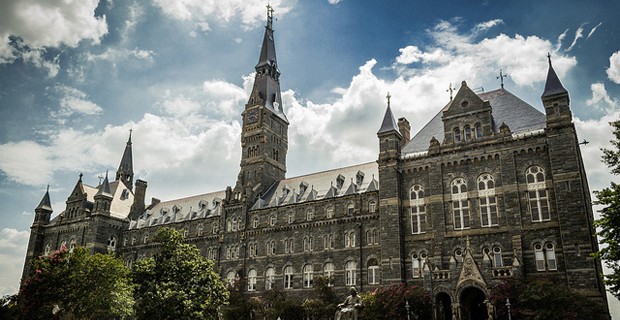
For Catholic parents with intelligent high school children, this can be a trying time. A good many ostensibly Catholic universities have simply become indistinguishable from the mass of U.S. colleges. Take Georgetown, for example, which the New York Times gleefully reports has become a gay-friendly campus.
Any attempt to resist the intense pressure to conform to lifestyle liberalism is treated as heresy by the left. Think of Sandra Fluke, who didn’t mind paying $40,000 a year for tuition at Georgetown Law, but who made a national issue out of a university health plan that didn’t cover the pill. Without insurance, that would have come to about $100 a year at a local Target store, which didn’t make it look like the social justice cause of our time. Unless, of course, one knew who the enemy was.
Then there’s the sheer expense of it all. There are good schools out there, to be sure. The problem is that it will often take a second mortgage to pay for them.
Clearly, it’s time to rethink the college experience. Right now, two models dominate American higher education, and both are broken. The first is the hugely expensive bricks-and-mortar university, which typically don’t teach anything much of value and indoctrinate students in a sloppy anti-religious, leftism. The second are the conventional, asynchronous (not real-time) online programs being adopted by many of these same institutions as a means of reducing costs.
Asynchronous courses, which are also offered by online schools such as the University of Phoenix, feature technical training in subjects such as accounting and computer science. The market works here, and one doesn’t see courses on Pulp Fiction (Georgetown English-219). Such course are also inexpensive, since they can be offered to thousands of people at the same time. Bandwidth is free, after all, and computers can evaluate multiple choice exam questions. But while asynchronous courses are cheap, they don’t include the crucially important real-time exchange of ideas. What’s also missing are the opportunities for informal discussion, pre and post class, which is so important to the learning process.
The first model has serious problems, which the second model can’t fix without creating those of its own. This leaves us with a tremendous hole in higher education, a hole that synchronous online schools will rise to meet. Among the first of these, LibertasU, will launch on September 9, with online courses given in the classical tradition. LibertasU’s Dean is Roger Scruton, well-known as a leading conservative intellectual, whose latest book is The Face of God.
Unlike a bricks-and-mortar school, a school such as LibertasU exists exclusively on the web, which means it eliminates all the costs of operating a standard, physical campus, to say nothing of the enormous waste on administrative expenses. This translates into lower tuition and, as such courses are readily available to anyone with a computer and Internet connection, provides students, whether they’re 16 or 86, the opportunity to study with first-rate educators, who themselves can be located anywhere in the world.
With synchronous online schools, teachers and students are present at the same time in scheduled classes. LibertasU takes this one step further. Rather than using simple video conferencing, classes are held in immersive virtual reality environments where each person assumes a body or avatar and is able to walk around, raise their hand to speak, and interact with others, in a group setting. Think of “Grand Theft Auto,” if designed by Plato. People report the experience to be just like being there, without the cost and disruption associated with travel to a bricks-and-mortar classroom. Additionally, it has been found that, when such environments are used, retention is much better and students are more likely to take part in the conversation....
What, after all, should a college do? Three things. A college should teach things that can’t be adequately mastered on one’s own. College should also assist in promoting desirable goals, be they spiritual or professional. And all this should be done in a cost-cutting, efficient manner. A school such as Georgetown flunks all three. That’s why the future of higher education, especially for Catholic conservatives, lies with a mixture of cutting-edge technology, first-rate teachers and classical courses.
Read the full article here: http://www.crisismagazine.com/2013/how-to-fix-our-system-of-higher-education?utm_source=feedburner&utm_medium=feed&utm_campaign=Feed%3A+CrisisMagazine+%28Crisis+Magazine%29


No comments:
Post a Comment